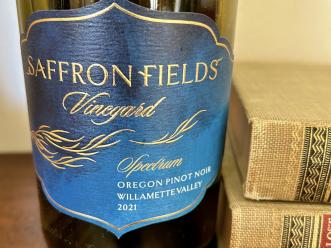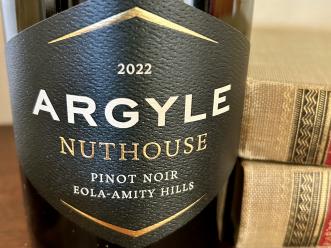Living here in Seattle, I admit I’m among the many that are proud of our famous wine regions and wines. Since I love to vacation on the Oregon coast, I find myself in the upper Willamette/Yamhill AVA a couple of times a year. This area is conveniently located along Route 18, the road leading from Portland to the coast, and it’s easy to hop on and off the freeway to visit a variety of wineries.
Yamhill contains all of the elements that I love when touring in a wine region – winding roads (I adore any road that comes with a “steep grade” or “blind curves” warning) , rolling hills, gorgeous views, wineries ranging from shacks to chateaus and of course, lovely wines. The climate is cool and somewhat damp, but you can get some hot days mid summer, making for perfect afternoons of sipping wine and nibbling on a picnic while enjoying stunning views.
It’s fitting that they grow Pinot Noir in Oregon, as it matches the highly individualistic people – they love a good challenge, and Pinot is known as a challenging grape. It thrives in cooler climates, but hates damp – and boy, is Northern Oregon damp! To combat the damp, vines are trellised to allow for good airflow and sun exposure to keep the grapes dry. There’s a strong Green movement and they’re very careful about the water runoff. If you see a sticker proclaiming that a wine from Oregon is “Salmon Safe”, it doesn’t mean that that the salmon approve of the wine, but rather that the grapes were farmed with as few chemicals as possible, to avoid leaching chemicals in the runoff.
Enough of the wine wonk talk. As I write this, all I can think about is the fantastic day I had north of Highway 18, wandering around in the hills. My visit to Elk Cove Vineyards was particularly lovely – it was September, just at the beginning of harvest and as I passed by a few wineries, I could smell the distinct, pungent aroma of crushed grapes in the air. Elk Cove Vineyards is situated in the Northern Willamette hills, requiring me to navigate quite of few of my beloved winding roads, and was well worth the trip. Situated at the tip of a hill, with ravines and lushly vined hills surrounding the tasting room, it really felt like a private grape saturated paradise at the end of the world.
They were preparing to harvest the next day and every creature on the property was nervy with anticipation. The staff was moving with great determination and the housedogs barked as they danced around the equipment as it was maneuvered into place. The air was thickly perfumed with the ripe fruit and the grapes that I tasted were deeply sweet and juicy. The birds agreed with me as they darted through the air, dive-bombing to snatch fruit from the vines. I jumped at the first shotgun crack, afraid I’d trespassed too far between the rows, but another one a few minutes later from the opposite direction made me realize that it was just the growers using sound machines to try and scare the birds away. The birds paid absolutely no attention, and continued to swoop freely in and out of the vines.
The Pinot Noir grape is used in both red wines and Blanc de Noir, a white Champagne or Sparkling wine – Blanc de Noir meaning “white from red”. It’s sometimes used in red blends but is best on its own where it can show its own profile- and that profile can change depending on where it’s made. In the Northwest, it’s on the fruity, berry side, sometimes with a little oak. In California, the fruit is often more restrained with a bit more earth and oak, and in France, they go full on earthy with flavors of tobacco and dirt. Of course, if you go Down Under, the Aussies ramp up the berry characteristics, and their Pinots range from berry to downright candied fruit flavors.
Because it’s a cool climate grape, the alcohol is moderate, but Pinot also has a good acidity, or tartness and smooth tannins, all of which combine to make it one of the most food friendly wines. It matches well with foods that pick up its characteristics so try to match the regional variance with the food. Oregon and California Pinots are perfect with slightly earthy or sweeter ingredients like berries. Try herb rubbed roasted pork with creamy polenta and sautéed wild mushrooms, or a bird with a cranberry stuffing – you can even use some of the Pinot as a reduction in the sauce.
A French Pinot with its stronger earth characteristics goes best with similarly full flavored, rustic foods – drink this style with braised meats. Coq au Vin and Beouf Bourguignon were created in Burgundy, home of Pinot Noir, and this is a case where matching the local food and wine creates magic.
If you want to experience Pinot Noir in its lightest form, have a bubbly Blanc de Noir, where the grape is gently pressed, but not macerated, so you get the fabulous berry characteristics and body in a white wine. Pair this elegant sparkling wine with appetizers such as smoked scallop canapés or even sushi.
Of course, the modern classic pairing of Oregon Pinot Noir and Northwest Salmon is something you have to try if you’re in the area. You can grill the salmon if you want, but don’t put too much of a char on it as the smoky flavor can overwhelm the wine. You may want to pan roast or bake the salmon for the best match. Season the salmon with fresh herbs, roast some sweet, creamy fingerling potatoes and pair with your favorite vegetable (try another local delicacy, sautéed fiddlehead ferns) for the perfect Northwest meal. Don’t forget to have a local blackberry cobbler for dessert, served with another famous Northwest beverage – coffee!






